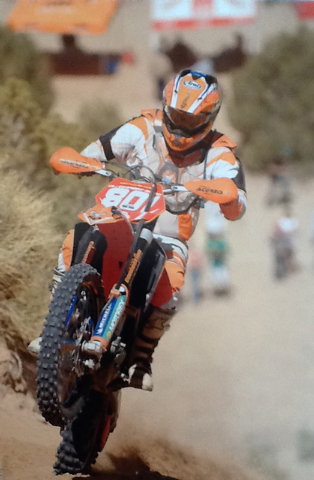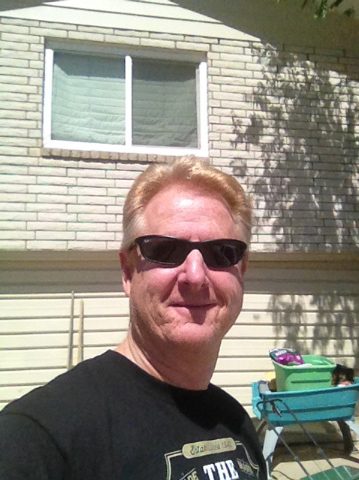Vegas to Reno motorcycle racer on the perils of riding in off-road races
Mike Whitman is an off-road desert motorcycle racer who has been racing for 45 years. He has won two Best in the Desert championships in 2008 and 2009. He races expert class, which is one step below professional and according to Whitman there are pro-riders, the experts and then novice riders.
On August 15, the longest off-road race in the country, the General Tire Vegas to Reno race starts in Beatty. The race attracts people from all over the country who want to go up against some of the best off-road desert racers in the country. Whitman hopes to be one of the winners in his class.
Whitman lives in Farmington, New Mexico where he is a pilot for United Airlines. “I have been doing this since I was a kid. I thought I would be over it by now, but I still love it as much as I did when I was a kid. I was riding a motorcycle long before I wanted to be pilot, I just have this need for speed,” Whitman said.
Whitman has been sponsored by C&J Equipment Manufacturing since 2007. “They have been supporting our efforts since 2007. They make oil and gas equipment. They have been instrumental in all our racing in both Mexico and in the Best in the Desert series. The company provides us with top-notch equipment. We never have not finished a race. We attribute our championships to the quality of help we get and the quality of the equipment,” he said.
Each year Whitman races in the Vegas to Reno race. To be in this race, Whitman says with food and lodging racers are looking at about $5,000 and that is not counting the cost of the motorcycle.
Motorcycle racing is similar to racing the trucks and cars, but it’s a bit more dangerous because you don’t have the protection of the cab he said. With motorcycles you must start and finish with the same bike that started the race. “I can’t change the frame. You can do an engine change. If you have an extra engine but you can’t change out the whole bike,” Whitman explained.
Like the cars and trucks, the motorcycles are protected from the hardships of desert racing. There is extra protection underneath the bike. In general, desert off-road bikes are different than a motocross bike. The protection would be significantly more, the suspension is even softer because the terrain is different and the bikes have a larger gas tank because of the longer distances.
The bikers themselves also have more protection. For example, there is hand guard protection against brush. “We think about that a lot because you don’t want to catch a cactus spine going 70-80 miles an hour through your finger which all of us have done. We have riding pants that are similar to what you would find in motocross. Another thing we carry that the motocross racers don’t is a hydration unit such as a Camel Back,” Whitman remarked.
Whitman believes the most important aspect of desert off-road racing on motorcycles is the suspension. Without good suspension, he said he wouldn’t be able to reach the high speeds he does. On average, his bike is going 60-70 miles per hour and may reach a top speed of 107. “We have special suspension too like the trucks,” Whitman told the PVT. ” If you want to be successful and want to go very fast you have to have suspension work done. We use precision concepts almost from the beginning. Bob Bell has extensive off-road experience in both the Best in the Desert and in Mexico. In my opinion, he makes the best off-road suspension in the business. We get airborne a lot intentionally or unintentionally.”
The average motorcycle is made for motocross. Even the bikes that are made for off-road are what you would call standard settings. He said riders have to tailor the motorcycle to your riding style and to your speed.
Whitman loves all the Best in the Desert courses. He says Casey Folks does a great job in putting time and effort into marking the course. “His courses are well marked and it is nearly impossible to get lost on one of the Best in the Desert courses. You just have to be a complete idiot to get lost,” he said. “It happens very rarely. There are mile markers every mile. He puts an extraordinary amount of attention to detail in marking the course,” Whitman remarked.
Getting lost is one thing and accidents are another. Surprisingly, Whitman has had only one bad wreck in his career and that was not on a Best in the Desert course.
“I got off pretty hard in the Baja 500 a few years ago. I broke my back, broke my arm and broke my toe. I then got up and rode for 75 miles to get the motorcycle to the next rider change. That was the worse crash I ever had. I chased around for the rest of the day and downed a lot of ibuprofen. Then when I went back to the United States I found out I broke my back. I didn’t even know that. I thought it was a bad sprain,” Whitman recalled.
This year Whitman will race the entire 500 miles of Vegas to Reno by himself. Normally he races with another driver, but this year he decided to go it alone as a special challenge.
“Managing your energy is your biggest challenge. Staying hydrated and you have to eat. Pacing is the biggest thing for you have enough energy to finish the event,” Whitman concluded.


















